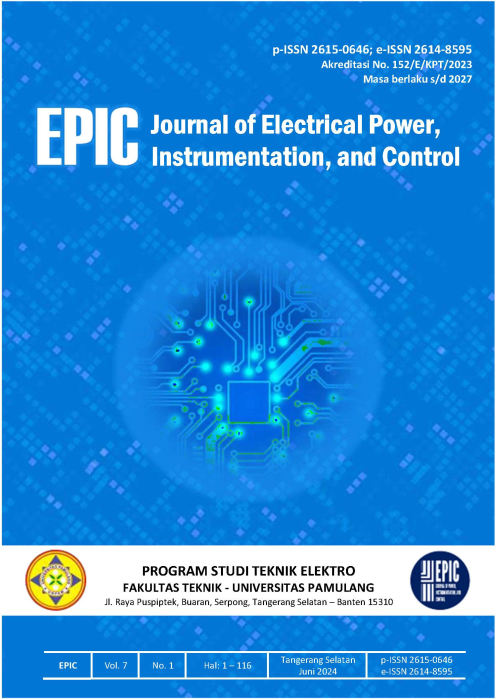Analisis Sistem Kendali Laju Aliran Fresh Water pada Industri Pulp dan Papper Proses Cooker di PT. XYZ
DOI:
https://doi.org/10.32493/epic.v7i1.39119Keywords:
Control system, fresh water flow rate, distributed control system, viscosityAbstract
This research focuses on the analysis of the flow rate control system of fresh water in the pulp and paper industry, specifically in the cooker process at PT. XYZ. The control system used involves feedback to ensure the consistency and quality of the final product. By utilizing a Distributed Control System (DCS), this study examines the closed-loop diagram, process flow, DCS programming, and the actual performance data of the fresh water flow rate control system. The results indicate that the control system effectively regulates the fresh water flow rate to achieve the desired viscosity in starch production. Although there is a slight deviation between the set point and the measured instrument reading, the resulting error remains within acceptable tolerances.
References
Abidin, U. Z., Rudati, P. S., & Feriyonika, F. (2019, August). Pengembangan Perangkat Lunak HMI Untuk DCS Pengendalian Suhu Pencampuran Air. In Prosiding Industrial Research Workshop and National Seminar (Vol. 10, No. 1, pp. 561-566).
Adhe, Y. N., Maria, P. S., Zarory, H., & Jufrizel, S. T. (2022). Analisa Pengendalian Level Berbasis MRAC-PID pada Tangki Hotwell Kondensor. CYCLOTRON, 5(2).
Aulia, A., Za, N., Sylvia, N., Hakim, L., & Bahri, S. (2022). Kajian Terhadap Kavitasi Dan Pressure Drop Pada Bukaan Control Valve Tipe Globe Valve Dengan Menggunakan Software Autodesk CFD (Computational Fluid Dynamics). In Chemical Engineering Journal Storage (Vol. 1, Issue 4).
Gunterus, F. (1994). Falsafah Dasar : Sistem Pengendalian Proses (1st ed.). Elex Media Komputindo.
Kurnia, D., Manik, T. S., & Yanto, Y. (2023). Sistem Pemodelan Flow Rate Control Menggunakan Teknologi 4.0 di Laboratorium Instrumentasi PTKI MEDAN. JURNAL VOKASI TEKNIK, 1(02), 1-9.
Novita, A. D., & Saragih, Y. (2024). Sistem Kontrol Level Transmitter pada Tangki FA–410 di PT. Sintas Kurama Perdana. Aisyah Journal Of Informatics and Electrical Engineering (AJIEE), 6(1), 35-44.
Rashati, D., Christiningtyas Eryani, M., & Jember, A. F. (2019). Evaluasi Sifat Fisik Sediaan Sampo Ekstrak Daun Katuk (Sauropus Androgynus (L) Merr) Dengan Berbagai Variasi Viscosity Agent (Vol. 1, Issue 1).
Reza, A., Finawan, A., & Teknologi Rekayasa Instrumentasi dan Kontrol, P. (2021). Rancang Bangun Plant Kalibrasi Electric Control Valve Dengan Metode Uji Linearitas Arus Terhadap Opening Control Valve. JURNAL TEKTRO, 5(1).
Ridho Prabowo, R., & Taufiq Subagio, R. (2020). Sistem Monitoring Dan Pemberian Pakan Otomatis Pada Budidaya Ikan Menggunakan Wemos Dengan Konsep Internet Of Things (IoT) (Vol. 10, Issue 2).
Saragih, K. (2023). Effect Of Adding Hydroxylammonium Sulfate To Mooney Viscosity In The Crumb Rubber Industry. Jurnal Rekayasa, Teknologi Proses dan Sains Kimia (REPROKIMIA), 2(1), 12-17.
Satyawira, B. (2018). Studi Laboratorium Pemilihan Additif Penstabil Shale Di Dalam Sistem Lumpur Kcl-Polimer Pada Temperatur Tinggi. In Journal of Mechanical Engineering and Mechatronics (Vol. 3, Issue 1).
Setiawan, M. F. R., Endryansyah, E., Haryudo, S. I., & Agung, A. I. (2022). Optimasi Sistem Monitoring Penghitung Produk Gula dengan Menggunakan SCADA Berbasis Distributed Control System (DCS). JURNAL TEKNIK ELEKTRO, 11(3), 463-470.
Singgih, H. S., Subiyantoro, S., & Siswoko, S. (2019). Aplikasi Kontrol Pid Pada Proses Pengolahan Air Laut Menggunakan Metode Reverse Osmosis Berbasis DCS. ELTEK 17, 32.
Suhendar. (2020). Analisis & Implementasi Menggunakan Matlab Dasar Teknik Kendali (D. Tesniyadi, Ed.; 1st ed.). Media Edukasi Indonesia (Anggota IKAPI).
Downloads
Published
How to Cite
Issue
Section
License
Copyright (c) 2024 EPIC Journal of Electrical Power Instrumentation and Control

This work is licensed under a Creative Commons Attribution-NonCommercial-ShareAlike 4.0 International License.
This journal provides immediate open access to its content on the principle that making research freely available to the public, supporting a greater global exchange of knowledge.

Journal of Electrical Power, Instrumentation and Control adhere to Attribution-ShareAlike 4.0 International license.
Journal of Electrical Power, Instrumentation and Control menganut lisensi Atribusi-BerbagiSerupa 4.0 Internasional.



















